Displaying items by tag: Compliments to the Chef, Paula and John Reardon
My Little Cupcake
Hello my Foodie Friends!
This coming week Paula and I will each celebrate another birthday (we stopped counting the years). One of our favorite desserts to have to celebrate is with a cupcake that allows us to each choose our own creative flavor. With so many special events such as baby and bridal showers, birthdays, and weddings, bakeries and small businesses have been busy making delectable desserts for these events. The cupcake is a baked good that has gained tremendous popularity over the past two decades. The big business and trend of making cupcakes has expanded through entrepreneurial bakers and bakeries taking advantage of the multiple varieties and creativity that can come with cupcakes. However, making your own cupcakes can be an endearing gift that you can make for yourself or for someone special.
So, what is your cupcake personality? Do you prefer to indulge in rich double chocolate or simply vanilla? Maybe a wonderful red velvet or carrot cake with cream cheese frosting? Peanut butter fudge sounds delicious or even salted caramel, mocha, or coconut. Whether your personality is fun and festive, salt and sweet, business like, lovey-dovey, colorful, adventurous, or serious, there is a cupcake flavor for you. Since their creation, cupcakes have become a pop culture trend in the culinary world. They have spawned dozens of bakeries devoted entirely to them. While chocolate and vanilla remain classic favorites, fancy flavors such as raspberry meringue and espresso fudge can be found on menus. There are cookbooks, blogs, and magazines specifically dedicated to cupcakes.
The history of cupcakes (retrieved from All About Cupcakes) is interesting to learn about. The cupcake evolved in the United States in the 19th century, and it was revolutionary because of the amount of time it saved in the kitchen. There was a shift from weighing out ingredients when baking to measuring out ingredients. According to the Food Timeline Web, food historians have yet to pinpoint exactly where the name of the cupcake originated. There are two theories: the cakes were originally cooked in cups, and the ingredients used to make the cupcakes were measured out by the cup. In the beginning, cupcakes were sometimes called “number” cakes, because they were easy to remember by the measurements of ingredients it took to create them: One cup of butter, two cups of sugar, three cups of flour, four eggs, one cup of milk, and one spoonful of soda. Clearly, cupcakes today have expanded to a wide variety of ingredients, measurements, shapes, and decorations - but this was one of the first recipes for making what we know today as cupcakes. Cupcakes were convenient because they cooked much quicker than larger cakes. When baking was done in hearth ovens, it would take a long time to bake a cake, and the final product would often be burned. Muffin tins, also called gem pans, were popular around the turn of the 20th century, so people started creating cupcakes in tins.
At Compliments to the Chef, your neighborhood kitchen and cutlery store located at 33 Railroad Place, we carry various accessories to assist you with making your favorite cupcake recipe. Cupcakes are a sweet way to please a crowd, and to say “thank you” or “I love you” to your little cupcake and to celebrate “another” birthday!! Remember my Foodie Friends: “Life Happens in the Kitchen.”
Take Care,
John & Paula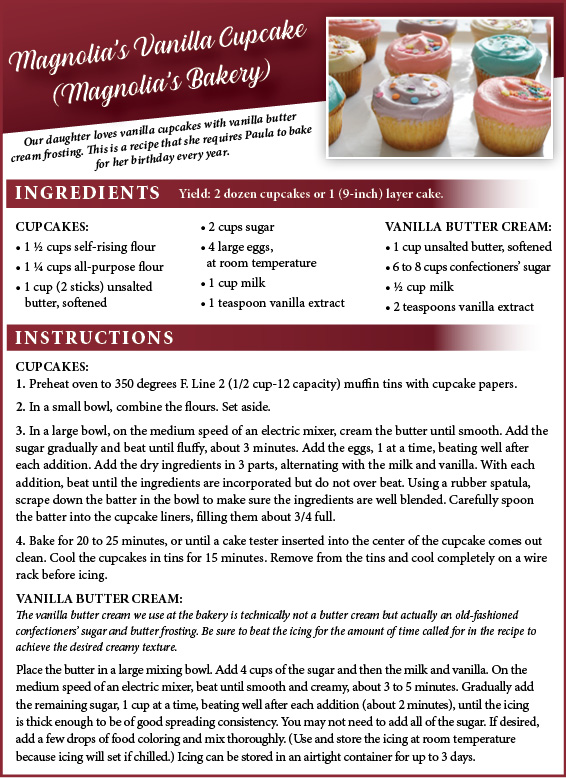
Spin Class for Foodies
Hello my Foodie Friends!
The summer sure went by fast with this being Labor Day weekend. With the weather still being warm comes the yearning for lighter fares such as salads. Creating imaginative salads was always a favorite thing to do by my children. When they were young (and still occurs) our eldest child, John would be accused (by his sister Aubrey) of not wanting to help in the kitchen with the making of the salads. One of the best and fun solutions was to get a Salad Spinner. This tool assisted us back then and still does today. How did we know our son liked it? When we would come home and the video game would be on pause and salad ingredients everywhere (we knew he was having fun and using the tool).
Why would you consider using a salad spinner? No one likes a wet salad. But there are two important reasons that go beyond personal preference that make spinning your salad a necessity. The first is that most salad dressings are oil-based. Water repels oil, and so salad greens covered in water will repel dressing. This will result in the dressing pooling at the bottom of your salad bowl instead of coating the greens.
The second reason to remove water from your salad is to retain its freshness. The more moisture that’s in your salad, especially if you’re not dressing the whole thing at once, the more quickly it will go bad. The leaves will turn brown and everything will lose its crisp texture if it sits in excess moisture. If you’re not planning on consuming all of your salad immediately, make sure each of its components is as dry as possible before combining them.
If those two essential warnings against wet greens have not convinced you that you need a salad spinner in your life, fear not, there are plenty of other reasons to get one. Many people think of salad spinners as one-trick ponies that only serve a single purpose and otherwise occupy more than their fair share of precious space in your home, but they actually have quite a number of alternate uses. Salad spinners are useful for washing and drying a wide variety of fruits and vegetables. They are ideal because you can wash and dry things in a single container, and the spinning action they use is delicate enough that it won’t damage or bruise your produce. The next time you need to wash berries, broccoli, green beans, or mushrooms, try using a salad spinner. You’re sure to delight in how dry its contents become, and how quick and easy it is to use. You can also use the internal compartment of your salad spinner as a colander for fresh-cooked pasta. If you’re making a cold dish like pasta salad, spinning the noodles to remove the excess starchy water will cool them more quickly and also help keep them from sticking together.
The basket is also great for defrosting meat and drying before cooking. Vegetables from which it is good to remove excess moisture before frying like zucchini, eggplant, and shredded potatoes, can also be dried in a salad spinner, rather than squeezed out by hand. It also works well as a small dryer for hand-washed delicates.
Do you wash your greens and berries? Washing your salad ingredients can reduce the risk of illness. Listeria and E-Coli are dangerous food-borne illnesses that have been present in unwashed salads. It is difficult to wash salads. The Salad Spinner is a tool that has become a kitchen must-have.
One of our favorites and best sellers is the OXO Good Grips Salad Spinner. We have them in larger and smaller sizes. Dry salad greens with a simple press of the soft, non-slip knob. The non-slip base keeps the bowl steady on the countertop and the built-in brake button stops the Salad Spinner for unloading. The basket doubles as a colander, and the lid comes apart for easy cleaning. The OXO Good Grips Salad Spinner was selected as one of People Magazine’s 2017 50 Food Faves. Salad Spinners, they bring siblings together! Stop by Compliments to the Chef, your Neighborhood Kitchen and Cutlery store located at 33 Railroad Place to check out the OXO Salad Spinner and an assortment of other cool tools for cooks. Remember my Foodie Friends, “Life Happens in the Kitchen.” Have a safe and wonderful Labor Day Weekend.
Take Care,
John & Paula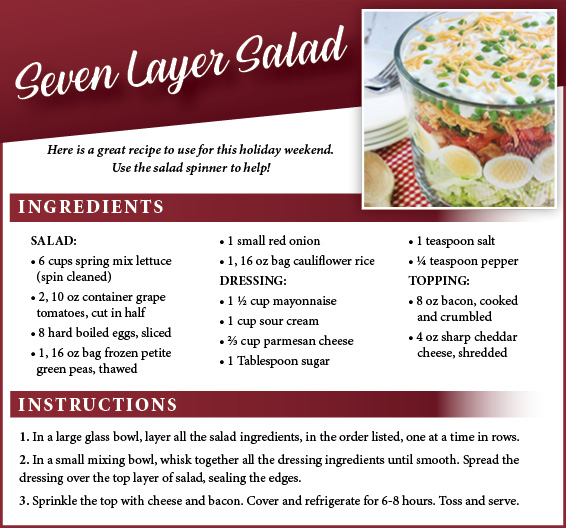
I Feel Good From my Head Tomatoes
Hello my Foodie Friends!
This past week and weekend celebrates my mother-in-law and my mother (who has passed) birthdays. As my family celebrate both of their birthdays, I reflect on my treasured childhood experiences especially during the end of summer weather. Along with this time of year came the time to work in the garden and harvest the incredible vegetables that we worked hard to grow and maintain over the summer. I love garden grown tomatoes. It often took all of my control to not bite into them as I was pulling them from their stems. Fresh tomatoes smell so good. My grandmother and mother always loved to make their sauce from home grown tomatoes. Therefore, in August and September, when tomatoes are at their ripest, it was a very busy time for me to help them in the garden. Every summer, when the garden was coming up tomatoes, my family would pass them through a chinois or food mill to get rid of skins and seeds. We would have fresh tomato sauce year-round. When you use a chinois or a food mill, tomatoes stay dense and rich.
The chinois is a cone-shaped strainer with a tightly woven mesh for filtering impurities from stocks, soups and sauces. To make the best use of a chinois, you’ll need a pointed wooden pestle, tailored to closely fit the bottom of the cone. The pestle allows you to easily press every last bit of juice and flavor from the solids. A stand is useful for holding the chinois upright over a pot or bowl. A chinois can be used for taking lumps out of gravy or even for taking the juice from citrus fruit. However, the most common use for a chinois is for making soup stock or sauces. For example, a chinois can be used to remove the seeds from tomatoes to prepare a fresh tomato sauce. Some people use a chinois to prepare apple sauce. It is also known as a bouillon strainer and it is commonly used for preparing soup stock as the conical shape helps funnel the stock into your pot. The fine mesh also keeps the bigger pieces of meat from the bones from going into the soup stock and clouding the clear broth.
To make a fresh sauce, dice tomatoes, then toss them in a pot and set it over moderate heat, stirring frequently. The tomatoes quickly begin dumping out their water as they heat up. Simmer the tomatoes until most of the excess liquid has cooked off, then transfer them to a chinois or a food mill. To peel the tomatoes, cut out the stem end and score an X into the skin with a sharp knife. Then drop them in boiling water until the skins just start to show signs of coming loose around the score marks (just about 30 seconds to a minute). Finally, transfer the tomatoes to an ice bath to shock them and stop the cooking; this will help loosen the skins even more. You should be able to just peel them right off with your hands. Dice the remaining tomato flesh, transfer it to a mesh strainer/ chinois or food mill, set over a bowl, and sprinkle it liberally with salt, which will draw out moisture. After about 30 minutes to an hour, puree the pulp with a blender. The puree has a very bright, fresh flavor, like gazpacho—but without any of the other ingredients, obviously. Included is a recipe for a fresh tomato sauce.
At Compliments to the Chef, your Neighborhood Kitchen and Cutlery store located at 33 Railroad Place, we carry cool tools for cooks to help with those culinary traditions. Working in the garden can make for some lifelong memories made with family and friends while sharing your culinary creations. Remember my Foodie Friends, “Life Happens in the Kitchen.”
Take Care,
John & Paula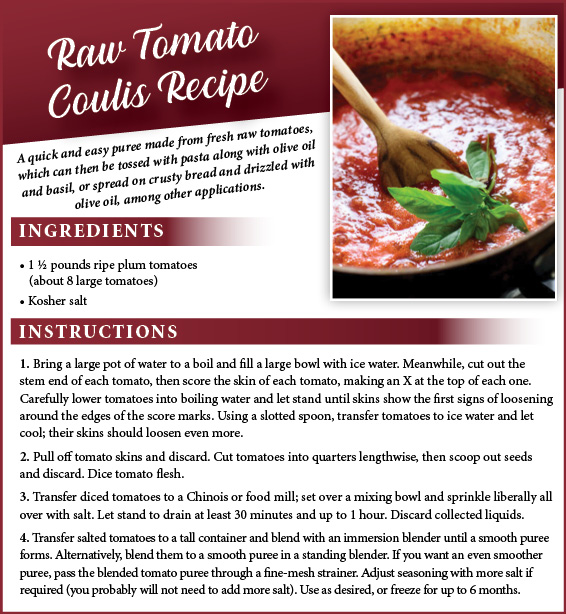
“Hey, She got the Way to Move Me, Cherry”
Hello my Foodie Friends!
Calling all Cherry lovers! As I think back on my childhood memories, I can remember the sheer joy of seeing my mom bringing a heaping bowl of bright red cherries to the table. Now we know that eating cherries as a part of a healthy diet full of fruits and vegetables may provide health benefits. Cherries are a good source of vitamin C. Vitamin C is a strong antioxidant. Cherries are also low in saturated fat and cholesterol. Last night I pitted and ate some delicious cherries and I slept like a baby. Who knew that they helped with sleep? Recently Dr. Russell J. Reiter, professor of neuroendocrinology at The University of Texas Health Science Center in San Antonio put some hard science behind the cherry folklore. He conducted a five-month study and found that tart cherries contain significant amounts of melatonin, a hormone produced in the brain’s pineal gland that has been credited with slowing the aging process, and fighting insomnia and jet lag. It’s also being studied as a potential treatment for cancer, depression and other diseases and disorders. The findings mark the first time melatonin has been pegged as a naturally occurring substance in food, although trace amounts are evident in bananas, corn and other foods, Reiter says.
You can also freeze cherries. You can freeze sweet cherries to enjoy in baked goods, smoothies, and sauces throughout the year. Simply rinse the cherries with cool water and remove the stem. Pitting them will make it easier to pop into a recipe later if they’re frozen without the pit. Once the cherries have been pitted, place them in a single layer on a baking sheet and place in the freezer overnight to freeze. After they’re completely frozen, put them in an airtight container or freezer bag to store in the freezer until you’re ready to use them. You won’t even need to thaw them before using them.
So kick back and enjoy those heartwarming childhood memories, while of course, savoring your own bowl full of sweet, juicy cherries—it’s a treat you can feel good about!
Use a cherry pitter to help you with taking the pits out. It will make your life easier. Most cherry pitters can also pit olives. At Compliments to the Chef, your Neighborhood Kitchen and Cutlery store located at 33 Railroad Place in Saratoga Springs, we carry cherry and olive pitters that can quickly and easily remove pits from cherries and olives without bruising or crushing fruit or wasting fruit. They are perfect for canning, freezing, dehydrating and baking cherries. One of our favorites is made by OXO. This cherry/olive pitter will make your life a lot easier with all of the delicious cherry recipes that are out there. The OXO pitter has a removable splatter shield that keeps juices contained and directed downward. It has a large holder that accommodates larger cherries and a recessed cup for smaller variety cherries.
By the way, I still love listening to Neil Diamond songs; especially while we are in the kitchen cooking or driving in the car. One of our favorites is “Cherry, Cherry.” Remember Foodie Friends: “Life Happens in the Kitchen.”
Take Care,
John & Paula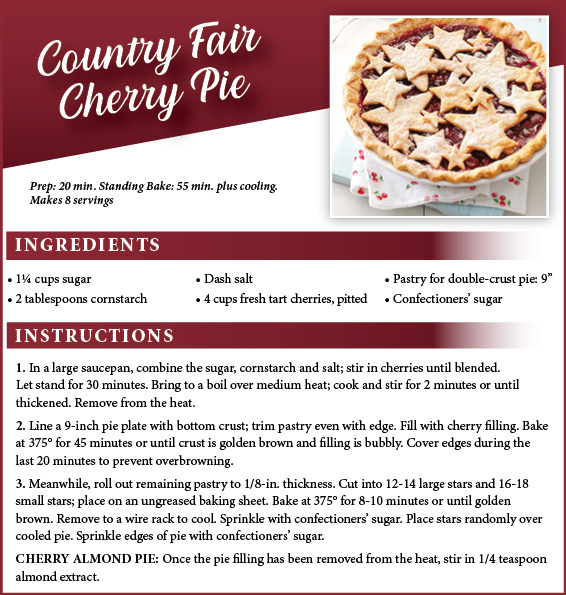
Food Prep Made Easy
Hello my Foodie Friends!
There is something magical about the act of preparing meals and eating together. It is an act of giving and sharing. During this summer as we continue to practice social distancing, we find ourselves making more family dinners, lunches, and breakfasts. Some of the joy that has emerged during this period has been the increased experience of eating together as a family. Our relationship with cooking has also changed. Many have used this time to become more adventurous with trying out new culinary skills and recipes we have wanted to try. In preparing that special culinary creation, there may be some cool culinary tools you need to help.
One tool that has become a “must have” in the kitchen drawer is the bench scraper. A bench scraper, which is also called a pastry scraper or dough scraper, is also used in working with pastry, bread, and other doughs. But even if you don’t bake regularly, it can still be a worthy investment for general cooking prep. It’s also space-efficient and easy to stow away in a prep drawer, and is a crazy-easy-to-clean, dishwasher-safe tool that can last you for decades. A bench scraper is one of those inexpensive utensils that lasts a lifetime and has a million uses.
When chopping vegetables, a bench scraper makes short work of transferring the veggies from the cutting board to the skillet or soup pot without losing half the veggies onto the floor during the transfer. Think of that flat piece of metal as a wide extension of your hand. Imagine the joy you would feel by only making ONE journey from your cutting board to your soup pot instead of your usual six trips as you balance those diced veggies on your knife or in your hand. You can also use your trusty scraper to smash whole cloves of garlic or to smash boiled potatoes before frying them.
Stop by Compliments to the Chef, your Neighborhood Kitchen and Cutlery store located at 33 Railroad Place to find those cool tools that can help you as you plan out your menus and get chopping. Relish the memories of cooking and eating together as a family! Remember my Foodie Friends, “Life Happens in the Kitchen.”
Take Care,
John & Paula
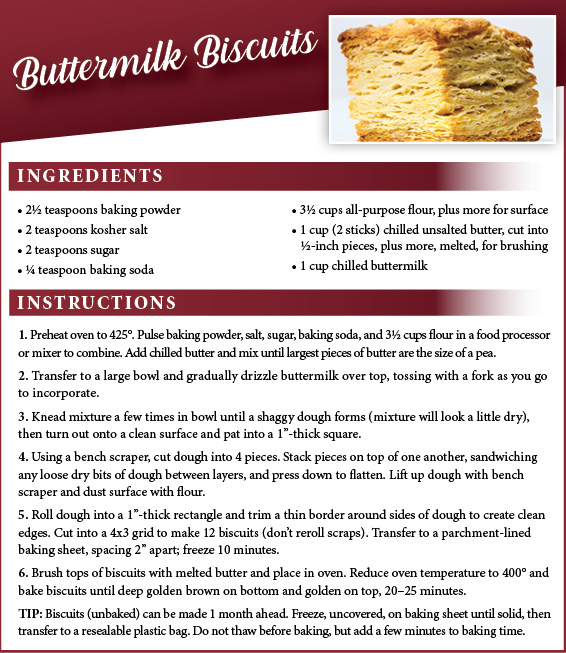
You are Gnocchi Listening
Hello my Foodie Friends!
Being Italian and Irish, both my daughter and I love her mom’s homemade sauce as part of the many Italian heirloom dishes made in our household. Among the most popular food that people associate with Italian cuisine, and sort of a staple in most Italian restaurants in the United States, are gnocchi [nyoh-ki]. These tiny dough dumplings most typically are made of semolina, parmesan cheese, flour, eggs, salt, and potatoes. But before we proceed right to how to make gnocchi, here are some factoids about these delectable dumplings you might want to know: According to historians, the earliest recorded mention of gnocchi was in the 14th century. Mention of them was discovered in Italian cooking manuscripts of that time period. There are many theories as to where gnocchi came from and how they were invented. One theory is that much like the origin stories of many traditional Italian dishes, these dumplings have Middle Eastern origins. The story is that as the Roman Empire expanded their territory, soldiers conquering lands in the Middle East discovered gnocchi, or its earliest predecessor anyway, along the way and liked them so much that they brought the recipe for them back to Italy. On the other hand, some historians also believe that gnocchi have been in existence in northern Italy as far back as the 12th century.
At Compliments to the Chef, we carry gnocchi boards to assist with making homemade gnocchi. The Gnocchi Board easily forms pasta dough into authentic Italian gnocchi. The ones we carry are made in Italy from natural beechwood; easy-grip handle maintains the perfect angle and keeps board steady for easier use. The board has ridges that help shape pasta and add texture which will hold more sauce; works nicely as a cavatelli maker, too. The gnocchi board forms a more consistent shape than using a fork; won’t flatten delicate dough; same size pieces cook more evenly and make more attractive presentation. The board is easy to use and clean; wipe with a dry cloth or brush. Once you make your gnocchi, you can add it to whatever your favorite sauce is. Be creative and have fun creating some unique combinations.
Stop by Compliments to the Chef, your Neighborhood Kitchen and Cutlery store, located at 33 Railroad Place to assist you with finding the cool tools to help with your culinary creations. Remember; “Life happens in the Kitchen.”
Take Care,
John & Paula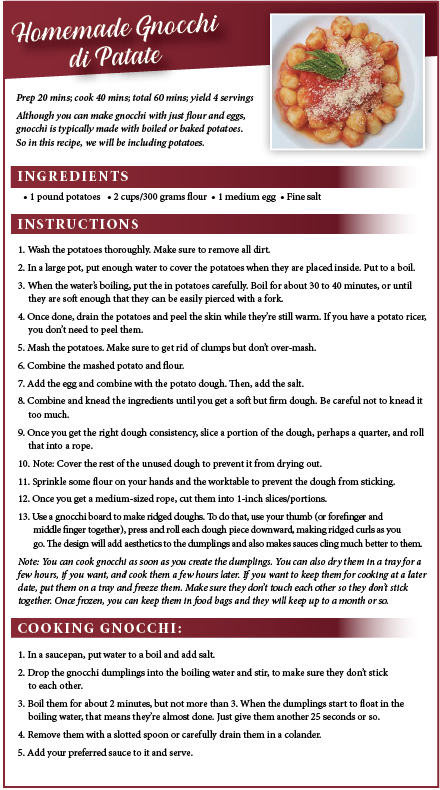
We’re Scaling Mountains
Hello my Foodie Friends!
We are living during difficult times because of the coronavirus pandemic. Those challenges can affect us both physically and emotionally.
Staying active during the COVID-19 pandemic is important for both our physical and mental well-being. During our recent times of social distancing, increased outdoor activity has been a positive trend; especially taking advantage of the beautiful Adirondack area we are part of.
Lace up your shoes and get on the trail. Whether running, biking, or simply taking a scenic stroll through the woods, this activity is safe and provides a wealth of health benefits. Chances are that your eating habits have changed a lot in the past few weeks. Along with the focus on our physical activity is our dietary approach to being home. Rather than downing chips—chocolate or potato—it is possible to look at this time at home as an opportunity to adopt or even improve healthy eating habits. Making healthier food choices can help with improving the quality of your diet. However, regulating the size of food portions is a simple process that can help with weight loss or avoiding weight gain. Weighing out food before it is eaten is a convenient method of controlling portion sizes and is something you can easily do at home with basic kitchen equipment. A digital kitchen scale can help with measuring.
A pointer to assist with weighing:
Weigh out the desired portion size. According to the U.S. Department of Health and Human Services, a standard portion for most meats and fish is 3 ounces. Look for portion size information on packages and use online resources such as MyPyramid.gov to learn about the recommended portion size of other foods. Weigh the food before it has been washed or cooked. Place the plate of food on the scale. The calibrated scale will measure the weight of the food only. Remove or add more of the foods until you reach the required portion. You can remove the plate as many times as you like provided that you do not press the tally button for a second time. For Food Safety reasons, you need to wash the plate thoroughly with hot water and detergent between weighing different foods.
We are cooking more at home now. Cooking puts you in control of the ingredients that end up in your meal. Many of us are really experiencing the joys of eating together with family regularly. Stop by Compliments to the Chef, your neighborhood Kitchen and Cutlery store, located at 33 Railroad Place in Saratoga Springs to select a digital scale to assist with weighing ounces, pounds, fluid ounces, grams, and milliliters. As we continue to scale the mountain during this time, use a scale at home to help you with your dietary and food management approach. Kitchen scales make cooking and baking much easier. Remember my Foodie Friends: “Life Happens in the Kitchen.”
Take Care,
John & Paula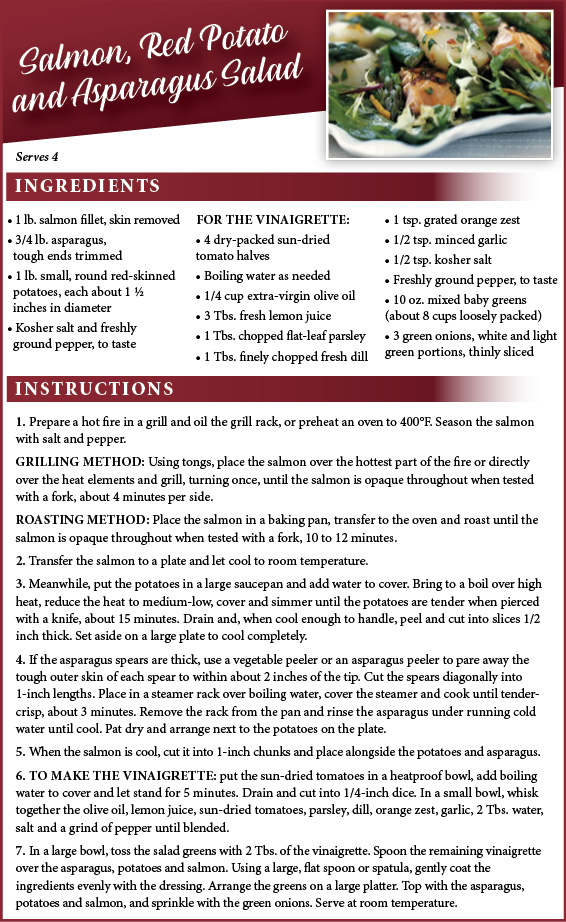
Big Boy Driving the Boat
Hello my Foodie Friends!
I love to tell this story especially during the summer and thinking about being at the ocean. Our family has precious memories of our summer experiences being on the coast of New England. Prior to moving to Upstate New York, we lived on the coast of Connecticut. Our good neighbors and friends, Ron and Deede, owned a fifty foot “boat” named “The Graduate” that they docked in West Greenwich Rhode Island in Narragansett Bay.
Weekend excursions included boating to Newport Rhode Island or just hanging out on the boat. Ron is a master captain in boating and comes from a military background in the Navy. He is also a master chef. Ron was always very proud driving “The Graduate” and serving his crew incredible seafood dishes. Ahh…what fabulous memories of our rides. Our children were very young at the time of most of our adventures. There was one very special time when Ron allowed three-year-old Johnny to take the helm and to sit in Ron’s chair to drive the boat. Johnny sat proudly with a very determined look in Ron’s captain’s chair, holding firmly onto the boats’ steering wheel and exclaimed “big boy driving the boat!” It was precious. Each summer that we were able to join Ron and Deede on “The Graduate,” Ron would allow Johnny to take the helm and be the “big boy driving the boat.” These are among the special memories of being on the water, with amazing friends, breathing in the sea air and feeling it on your skin. With boating brought the feasting on spectacular seafood meals made by Ron and Deede. Clams and oysters were one of Ron’s favorite seafood items to create delightful dishes with. Special tools that Ron would use included a clam and oyster knife and a cut proof glove. The clam knife was important for proper shucking of the clams. Once you learn the basics, shucking clams and oysters is not difficult. Practice makes perfect and the reward is delicious. It all starts in the preparation.
1. Make sure the clams you're going to be shucking are alive. A clam shell that is open or opens easily by hand is dead. Throw away any open clams.
2. Clean your clams using a stiff brush under cold running water to remove any sand and salt.
3. You may skip this step but soaking your clams will flush through any sand they may have inside. Use 1/3 of a cup of salt per gallon of cold water. Stir the salt until it dissolves. Soak the clams for 30-45 minutes then drain.
4. Either refrigerate your clams for at least an hour or pack them in ice for 30 minutes. This puts them to sleep and makes it easier for you to open them. I prefer the ice method.
5. Make sure you have a towel and a clam knife.
This summer make some seafood meals to remind you of the ocean and those precious memories you have made with friends and family. In my mind, I am dreaming of being the “big boy driving the boat!” Stop by Compliments to the Chef, your Neighborhood Kitchen and Cutlery store located at 33 Railroad Place for your seafood tools and other cool tools to help you with your summer cooking. Remember my Food Friends, “Life Happens in the Kitchen” with good times, friends, and great food (gathering safely).
Take Care,
John & Paula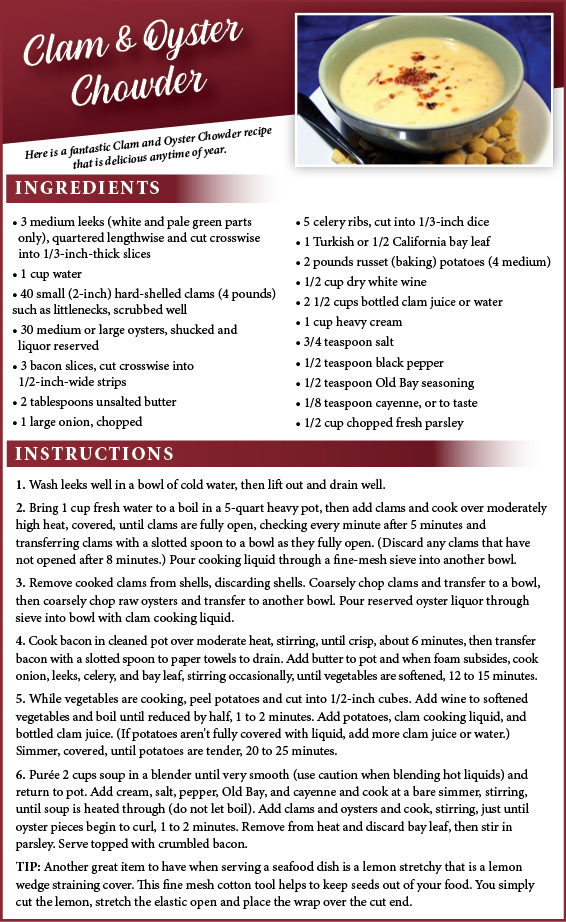
Just Muddling My Way Along!
Hello my Foodie Friends!
This Fourth of July weekend during Covid-19 restrictions will hinder but not stop our family and friends from getting together safely. Our gatherings will be more thought out and the right people will be with us. A toast or two will be made and what will you be holding? The drink I will be requesting is the Mojito! If you like Mojitos, and you’re like me, then they have to be made right. This is a classic summer cocktail and if it’s made correctly it’s delicious.
An essential tool to use to make a Mojito is a “muddler.” The muddler is basically a stick you use to smash ingredients into a bottom of a glass. It is used like a pestle to mash or muddle fruits, herbs, and spices. The classic muddler is a rod with a slight flare on one end and a flat surface or teeth on the other side. Both the flat surface and the teeth surface are appropriate for “muddling.” The purpose to “muddle” is to release fresh flavors to the liquid that will enhance your drink. Bartenders use a muddler to crush ingredients such as lemons, limes, and mint against the glass before pouring ice in. The muddler can also be used to stir a drink. Here are some tips of “muddling.”
• In most cases, the point of muddling is not to smash the ingredients into a messy pulp, but to gently caress the essence out of it and this is where a lot of new bartenders go wrong.
• Place your ingredients in the bottom of a cocktail shaker or mixing glass. Some cocktails are muddled directly in the serving glass as well.
• Gently press down and give a half turn of the muddler.
• Release and continue this motion until sufficiently muddled. This will generally take about 4-6 turns.
• Don’t muddle in a shaker that has a plastic bottom because they are prone to cracking, even under the lightest of pressure.
• Muddle before adding ice or you are just crushing ice, potentially over diluting the drink, and not properly muddling the ingredients that need it.
Ahhh…I love summer.
Being outdoors and enjoying fun times with family and friends (safely) creates those memories that last a lifetime.
This Fourth of July weekend, don’t get caught trying to “muddle your way through” making a Mojito without a muddler. Stop by Compliments to the Chef, Saratoga Springs’ true kitchen essentials store located at 33 Railroad Place to pick up the tools you need to make your weekend an enjoyable one! Remember; “Life Happens in the Kitchen.” Happy Fourth of July!
Take Care,
John & Paula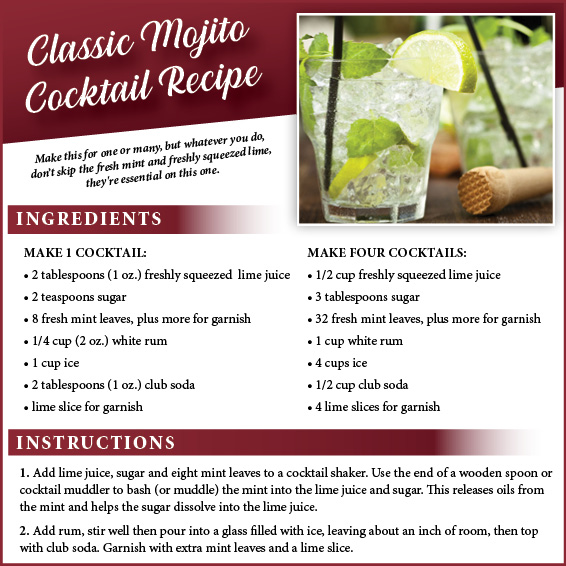
Controlled Spiral
Hello my Foodie Friends!
Sunny days and warmer weather remind me of some of my treasured childhood experiences. Getting to spend more time outdoors was my favorite for many reasons; sunshine and swimming, the feel of grass on my feet, the sound of the ice cream truck, melting pop sickles and ice cream cones, and playing baseball outdoors until dark. The weekend days allowed me and my brothers and sisters to sleep in a bit. However, we would always awake early and would roll over and talk until my mother came in to get us moving to eat breakfast.
Our yard was always full of the neighborhood kids. Some of them were there before we even finished breakfast, just waiting for the five Reardon children to come out to play. Among my childhood memories include the visual of the beautiful vegetable gardens that almost every family in my neighborhood had. Don’t get me wrong because as a child I did not like working in the garden. On hot n’ humid days my Mom ordering us to weed and remove bugs from her vegetables was beyond fun! The bugs looked cool though. My mother and my grandmother took much pride in how big the tomatoes or the eggplants were. When we would come in from playing for lunch or a snack, vegetables were always part of what was served such as a wonderful cucumber and tomato salad, zucchini, or carrot sticks (all that came from the garden). Recently, I was reminiscing with my sister about our childhood friends and us playing Hide N Go Seek in the corn fields next to our neighborhood, the outdoor fun we had, and shared our ongoing challenge of eating those vegetables as adults that we so often were eating as children.
During the warmer weather, none of us want to be in the hot kitchen for too long. This time of year is all about feeling light and healthy to combat the hot and humid temperatures. The last thing we want to do is stand over a stovetop or turn the oven on. With gorgeous weather and heat waves, we want to spend as much time outside as possible, soaking up the sun rays. However, we still want to eat healthfully. If you want to minimize the time you’ll be in the kitchen but still feel good (from the inside out, of course), then we have a cool tool that may help you feel inspiralized; the Vegetable Spiralizer. Vegetable Spiralizing is your key to healthy and light meals. The spiralizer is a kitchen tool that turns vegetables and fruits into noodles. Those noodles can then be used to make healthy pasta, noodle, salad dishes and more. While these veggie noodles can be cooked, they’re equally as delicious in their raw, cold form – perfect for easy, no-fuss, no-cook meals. By spiralizing, you’re naturally eating more vegetables – without even noticing (especially when they’re covered in a delicious tomato basil sauce!). Vegetables are high in water (such as zucchinis) and help detox your body, ridding it of unwanted toxins and leaving you refreshed and hydrated. Vegetables have an abundance of dietary fiber, which helps keep you fuller longer and help with your everyday digestion. Certain vegetables even help spike the metabolism, such as zucchinis.
What are the Best Veggies for Spiraling? You can transform all sorts of vegetables into noodles, but the best candidates are those that are firm (not floppy) and long or that can be cut long (if you want long spaghetti that you can easily spiral). One of the best aspects of veggie noodles is their spectacular names. Here are some of the best vegetables for spiraling (Paula found these terms not me):
• Zoodles (zucchini noodles) • Coodles (carrot noodles)
• Swoodles (sweet potato noodles) • Squoodles (squash noodles)
• Boodles (broccoli stem noodles) • Poodles (parsnip noodles)
• Toodles (turnip noodles)
At Compliments to the Chef, your Neighborhood Kitchen and Cutlery store located at 33 Railroad Pl., we carry several brands of Vegetable Spiralizers and even small hand held ones you can bring with you camping or to a friend’s or relative’s house to assist you. Enjoy the outdoors – maybe even start a garden. It will make for some lifelong memories made with family and friends while sharing your culinary creations. Remember my Foodie Friends, “Life Happens in the Kitchen.”
Take Care,
John & Paula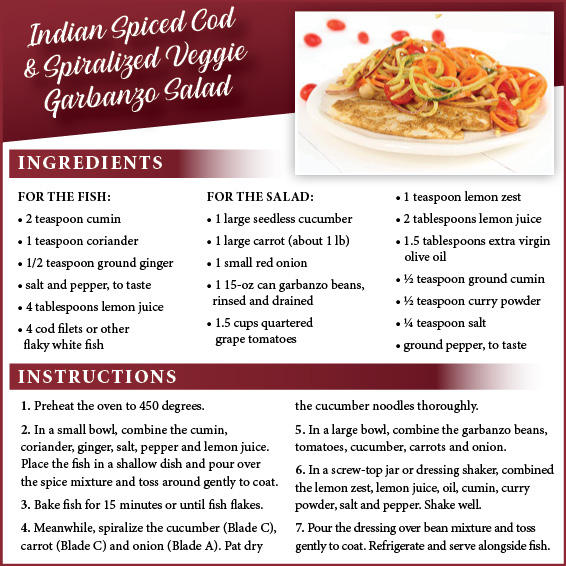
































 How to resolve AdBlock issue?
How to resolve AdBlock issue? 









